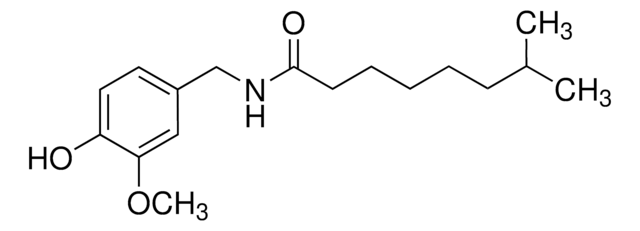M1022
Dihydrocapsaicin
from Capsicum sp., ≥85% (HPLC), powder, VR1 vanilloid receptor agonist
Synonyme(s) :
6,7-Dihydrocapsaicin, 8-Methyl-N-vanillylnonanamide, N-[(4-Hydroxy-3-methoxyphenyl)methyl]-8-methylnonenamide
About This Item
Produits recommandés
product name
Dihydrocapsaicin, from Capsicum sp., ≥85%
Source biologique
Capsicum sp.
Pureté
≥85%
Température de stockage
2-8°C
Chaîne SMILES
COc1cc(CNC(=O)CCCCCCC(C)C)ccc1O
InChI
1S/C18H29NO3/c1-14(2)8-6-4-5-7-9-18(21)19-13-15-10-11-16(20)17(12-15)22-3/h10-12,14,20H,4-9,13H2,1-3H3,(H,19,21)
Clé InChI
XJQPQKLURWNAAH-UHFFFAOYSA-N
Informations sur le gène
human ... TRPV1(7442)
rat ... Trpv4(66026)
Vous recherchez des produits similaires ? Visite Guide de comparaison des produits
Application
- as a standard to analyze the level of dihydrocapsaicin in endogenous An2 and capsaicin synthase silenced fruits
- as an external standard to determine the variability in capsaicinoid content in different landraces of capsicum
- in the activation or ablation of capsaicin-sensitive primary afferents (CSPA) fibres
Actions biochimiques/physiologiques
Liaison
Mention d'avertissement
Danger
Mentions de danger
Conseils de prudence
Classification des risques
Acute Tox. 2 Oral - Eye Irrit. 2 - Skin Irrit. 2 - STOT SE 3
Organes cibles
Respiratory system
Code de la classe de stockage
6.1A - Combustible acute toxic Cat. 1 and 2 / very toxic hazardous materials
Classe de danger pour l'eau (WGK)
WGK 3
Point d'éclair (°F)
Not applicable
Point d'éclair (°C)
Not applicable
Équipement de protection individuelle
Eyeshields, Faceshields, Gloves, type P2 (EN 143) respirator cartridges
Certificats d'analyse (COA)
Recherchez un Certificats d'analyse (COA) en saisissant le numéro de lot du produit. Les numéros de lot figurent sur l'étiquette du produit après les mots "Lot" ou "Batch".
Déjà en possession de ce produit ?
Retrouvez la documentation relative aux produits que vous avez récemment achetés dans la Bibliothèque de documents.
Les clients ont également consulté
Notre équipe de scientifiques dispose d'une expérience dans tous les secteurs de la recherche, notamment en sciences de la vie, science des matériaux, synthèse chimique, chromatographie, analyse et dans de nombreux autres domaines..
Contacter notre Service technique






